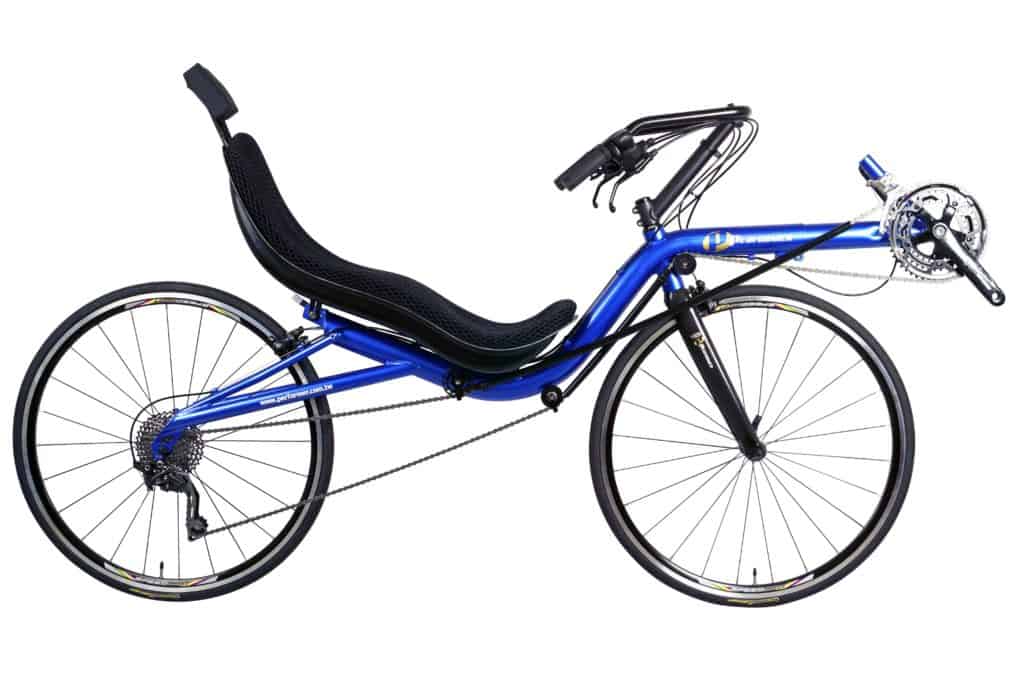Introduction: What is a Recumbent Road Bike?
A recumbent road bike differs significantly from traditional upright bicycles. It positions the rider in a reclined, laid-back posture. This unique design offers several benefits including comfort, aerodynamics, and efficiency. Unlike conventional bikes where riders sit upright and lean forward, recumbent bikes allow riders to sit back and enjoy a relaxed riding experience. This article delves into the intricacies of recumbent road bikes, their benefits, and why they are becoming increasingly popular.

The Rise in Popularity
Recumbent road bikes have been around for decades but have seen a surge in interest recently. Many cyclists find the ergonomic design appealing, particularly for long-distance rides. The growing popularity is also driven by increased awareness of the health benefits associated with these bikes. As more people look for comfortable and efficient ways to stay active, recumbent road bikes are emerging as a top choice. The unique design and smart engineering make them suitable for a variety of terrains and riding conditions.
Benefits of Recumbent Road Bikes
Recumbent road bikes offer numerous benefits that make them an attractive option for cyclists of all levels. These benefits range from improved comfort to enhanced aerodynamics and safety. Each advantage contributes to a better and more enjoyable cycling experience.
Enhanced Comfort
Comfort is one of the most significant benefits of recumbent road bikes. The reclined seating position distributes the rider’s weight across a larger area. This reduces pressure on the buttocks, back, neck, and hands. A larger, cushioned seat replaces the narrow saddle found on traditional bikes. This feature is particularly beneficial for individuals with back problems, joint pain, or other physical limitations.
Additionally, the ergonomic design allows riders to pedal in a more natural and relaxed posture. This minimizes muscle strain and fatigue, enabling longer rides without discomfort. Recumbent road bikes often feature adjustable seats and handlebars, allowing riders to customize their fit. This adaptability ensures maximum comfort and reduces the risk of injury.
Improved Aerodynamics
Recumbent road bikes offer superior aerodynamics compared to upright bikes. The reclined riding position lowers the rider’s profile, reducing wind resistance. This streamlined posture allows for more efficient riding, especially at high speeds. Recumbent bikes have been proven to be faster in competitive racing settings due to their aerodynamic advantage.
The design of these bikes channels airflow smoothly over the rider’s body. This eliminates the drag caused by an upright posture. The result is less energy expended to maintain speed, making recumbent bikes ideal for long-distance cycling and time trials. Serious cyclists and enthusiasts who seek to improve their performance often find recumbent road bikes a valuable addition to their arsenal.
Reduced Impact and Safety
Safety is another critical advantage offered by recumbent road bikes. The low center of gravity enhances stability, making them less prone to tipping over. This stability makes handling the bike easier, even at higher speeds. Additionally, the reclined position keeps the rider closer to the ground, reducing the severity of potential falls.
Recumbent bikes also reduce the impact on joints. The seating position allows for smooth pedaling with minimal strain on the knees and hips. This is particularly beneficial for individuals with arthritis or other joint issues. The design encourages an even distribution of force, further protecting the joints and reducing the risk of overuse injuries.
Types of Recumbent Road Bikes
There is a variety of recumbent road bikes available, each designed for specific purposes and preferences. Understanding the different types can help potential buyers make informed decisions.
Short Wheelbase Recumbent Bikes
Short wheelbase (SWB) recumbent bikes have a compact design. The front wheel is placed beneath or slightly behind the rider. This configuration results in a more agile and responsive bike. SWB recumbent bikes are suited for riders who prioritize maneuverability and speed. They are often used in competitive cycling and fast-paced riding environments.
The compact design allows for a more aerodynamic position, enhancing speed and efficiency. Additionally, SWB recumbent bikes offer better stability at higher speeds. Riders who enjoy quick, sharp turns and responsive handling often prefer this type of recumbent bike.
However, the shorter wheelbase may compromise comfort for some riders. The seating position is more reclined, which can put more strain on the lower back and legs. Prospective buyers should test these bikes thoroughly to ensure they meet their comfort and performance needs.
Long Wheelbase Recumbent Bikes
Long wheelbase (LWB) recumbent bikes feature an extended frame design. The front wheel is placed further ahead of the rider, resulting in a more relaxed and stable ride. LWB recumbent bikes are ideal for long-distance touring and casual cycling. Their design prioritizes comfort and smooth handling over agility and speed.
The extended frame provides a more upright seating position, reducing strain on the lower back and legs. This makes LWB recumbent bikes an excellent choice for individuals with back issues or those who prefer a more relaxed riding posture. The stability offered by the long wheelbase also makes these bikes easier to handle for beginners.
LWB recumbent bikes are known for their ability to absorb road vibrations, further enhancing comfort on long rides. However, they are less maneuverable than SWB recumbent bikes and may not be suitable for fast-paced cycling or competitive racing.
Trike Recumbent Bikes
Trike recumbent bikes, known as recumbent tricycles, offer three-wheel stability. They are an excellent choice for individuals seeking maximum stability and ease of use. Trikes are ideal for riders of all ages and abilities, including those with balance issues or mobility limitations.
Recumbent trikes come in various configurations, including delta (one front wheel, two rear wheels) and tadpole (two front wheels, one rear wheel) designs. Each configuration offers unique handling characteristics and may be suited to different riding styles. Trikes provide a relaxing and enjoyable cycling experience, with the added assurance of greater stability.
The ergonomic seating position and additional support make trikes extremely comfortable for long rides. They are also designed to handle various terrains, from paved roads to off-road trails. While recumbent trikes may be slower than two-wheeled recumbent bikes, they offer unparalleled stability and comfort, making them an excellent option for a wide range of riders.
Factors to Consider When Choosing a Recumbent Road Bike
Selecting the right recumbent road bike involves considering several factors. Potential buyers should evaluate these aspects to ensure their chosen bike meets their specific needs and preferences.
Rider’s Physical Conditions and Needs
Understanding one’s physical condition is crucial when choosing a recumbent road bike. Individuals with back problems, joint issues, or other physical limitations should prioritize comfort and ergonomic design. Recumbent bikes offer various levels of support and adjustability to accommodate different body types and needs.
Additionally, riders should consider their fitness levels and riding experience. Beginners may find trikes or LWB recumbent bikes more suitable due to their stability and ease of use. Experienced cyclists seeking performance and speed may prefer SWB recumbent bikes for their agility and aerodynamic benefits.
Intended Use and Riding Environment
The intended use and riding environment play a significant role in choosing the right recumbent road bike. Riders should consider their typical cycling activities, such as commuting, touring, or competitive racing. Each type of recumbent bike offers unique advantages suited to specific scenarios.
For long-distance touring, comfort is paramount. LWB recumbent bikes and trikes ensure a smooth and relaxed ride, making them ideal for extended journeys. Competitive cyclists may prioritize speed and efficiency, making SWB recumbent bikes a better choice.
Riding environments also influence the decision. Riders who frequently navigate urban areas or tight spaces may benefit from the maneuverability of SWB recumbent bikes. Those who enjoy off-road adventures or varied terrains should look for bikes designed to handle different surfaces robustly.
Budget and Maintenance
Budget considerations are essential when choosing a recumbent road bike. Prices vary widely based on factors such as brand, materials, and features. Entry-level models are generally more affordable and provide basic functionality. High-end models offer advanced features, superior materials, and enhanced performance but come at a higher price.
Maintenance requirements should also be considered. Recumbent bikes, especially those with complex configurations like trikes, may require specialized maintenance. Potential buyers should evaluate the availability of parts and repair services in their area. Investing in a reputable brand with good customer support can ensure reliable maintenance and trouble-free riding.
The Future of Recumbent Road Bikes
The future of recumbent road bikes looks promising with ongoing innovations and increasing popularity. Advances in materials, technology, and design continue to enhance their performance and appeal.
Technological Innovations
Technological innovations are driving the evolution of recumbent road bikes. Lightweight materials such as carbon fiber and advanced composites are being used to create more efficient and robust frames. These materials reduce the bike’s weight while maintaining strength and durability, enhancing overall performance.
Electric assist technologies are also making their way into the recumbent bike market. E-assist recumbent bikes feature electric motors that provide additional power, making it easier to tackle challenging terrains and long distances. This technology is particularly beneficial for older riders or those with physical limitations.
Smart integration and connectivity are becoming more prevalent. Smart sensors, GPS, and fitness tracking features are now available on some recumbent bikes. These technologies provide valuable data and enhance the riding experience. Users can track their performance, navigate routes, and stay connected while riding.
Growing Popularity and Community
The growing popularity of recumbent road bikes is fostering a vibrant community of enthusiasts. Online forums, social media groups, and local clubs are bringing riders together. This community provides valuable support, advice, and camaraderie for both new and experienced riders.
Events such as recumbent bike rallies, races, and tours are becoming more common. These events celebrate the unique attributes of recumbent bikes and offer opportunities for riders to showcase their skills. They also help to raise awareness and promote the benefits of recumbent cycling.
As more people recognize the advantages of recumbent road bikes, their popularity is expected to continue growing. The increasing demand is driving manufacturers to innovate and expand their offerings. This positive feedback loop ensures that the recumbent bike market will continue to evolve and thrive.
Conclusion: The Appeal of Recumbent Road Bikes
Recumbent road bikes offer a unique and appealing alternative to traditional upright bicycles. Their design prioritizes comfort, aerodynamics, and safety, making them an excellent choice for a wide range of riders. Whether for long-distance touring, casual commuting, or competitive racing, recumbent road bikes provide distinct advantages.
The variety of types, from short wheelbase and long wheelbase to trikes, ensures that there is a recumbent bike suited to every preference and need. Considering factors such as physical conditions, intended use, and budget can help potential buyers choose the perfect recumbent road bike.
Technological innovations and a growing community of enthusiasts are driving the future of recumbent road bikes. As they become more popular, continuous advancements in materials and design will further enhance their performance and appeal.
In summary, recumbent road bikes offer a comfortable, efficient, and enjoyable cycling experience. Their unique design and thoughtful engineering make them a worthwhile investment for anyone looking to enhance their cycling journey. With ongoing innovations and an increasing fan base, the future of recumbent road biking looks bright and promising.




